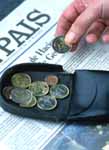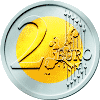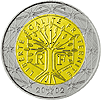On January 1, 1999 France started the
process of giving up its old currency, the Franc.
History of the Franc Historically, each country has seen
many changes in the coins people used to accept in the
course of business. France also had: le louis,
l'écu, la livre... also l'ange d'or, la
couronne d'or, le noble d'or, l'angelot d'or... ("d'or"=
of gold). The "modern" Franc dates from 1795,
when the new Republic (after the Revolution)
made everyone use a single legal currency called le franc
germinal. Europe-wide changeover As well as France, the historic
changeover also included Austria, Belgium, Finland, Germany,
Ireland, Italy (and the Vatican City), Luxembourg, the
Netherlands, Portugal, Spain - plus Greece which decided to
join in from January 1, 2001. Euro bank notes and coins began
circulating in France and the other countries on January 1,
2002. All transactions in France must now be
valued in Euros.

 Changing
from the Franc to the
Changing
from the Franc to the ![]() EURO
EURO
Back to
top
The Franc lasted for 641years. It was first minted to pay a
ransom for French King Jean the second (the Good) when he
was captured by the English in the disastrous Battle of
Poitiers (1360), during the Hundred
Years' War. The gold coins
that released him were called "franc-or" - "free gold".
France was one of the 12 countries in the European Economic
and Monetary Union (EMU) which decided to drop their
separate national currencies in favour of a new common
European currency - the EURO.



Getting used to the
change...
Credit: Audio Visual Library European Commission
















- each country has its own design for the reverse. These
French coins are accepted in ALL Euro countries - not just
France, and you can pay in France with the other countries'
EURO coins.


You may soon find EURO coins from other countries in your
change -
these are the reverse sides of the 1 EURO coins issued in
Germany and Spain. Back
to top







- you can spend them in any EURO
country.
|
|
|
|
|